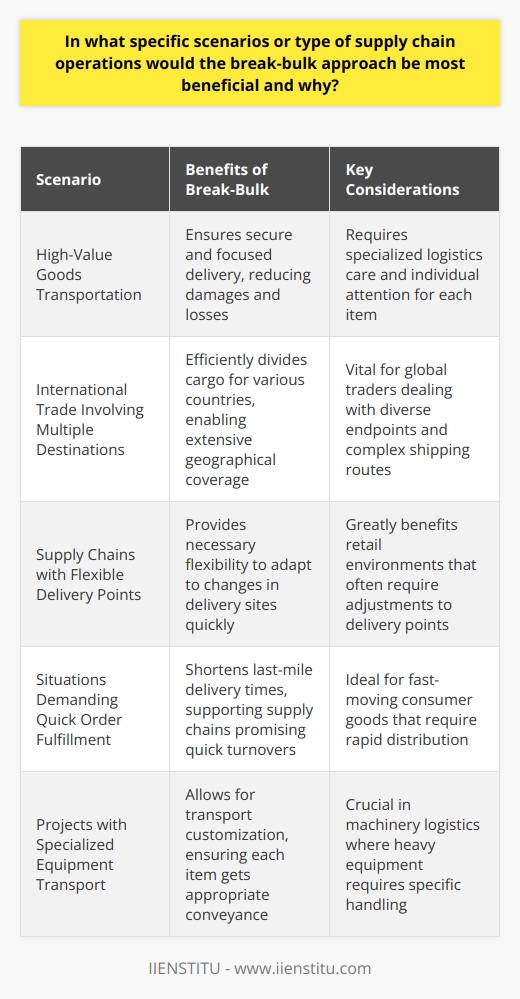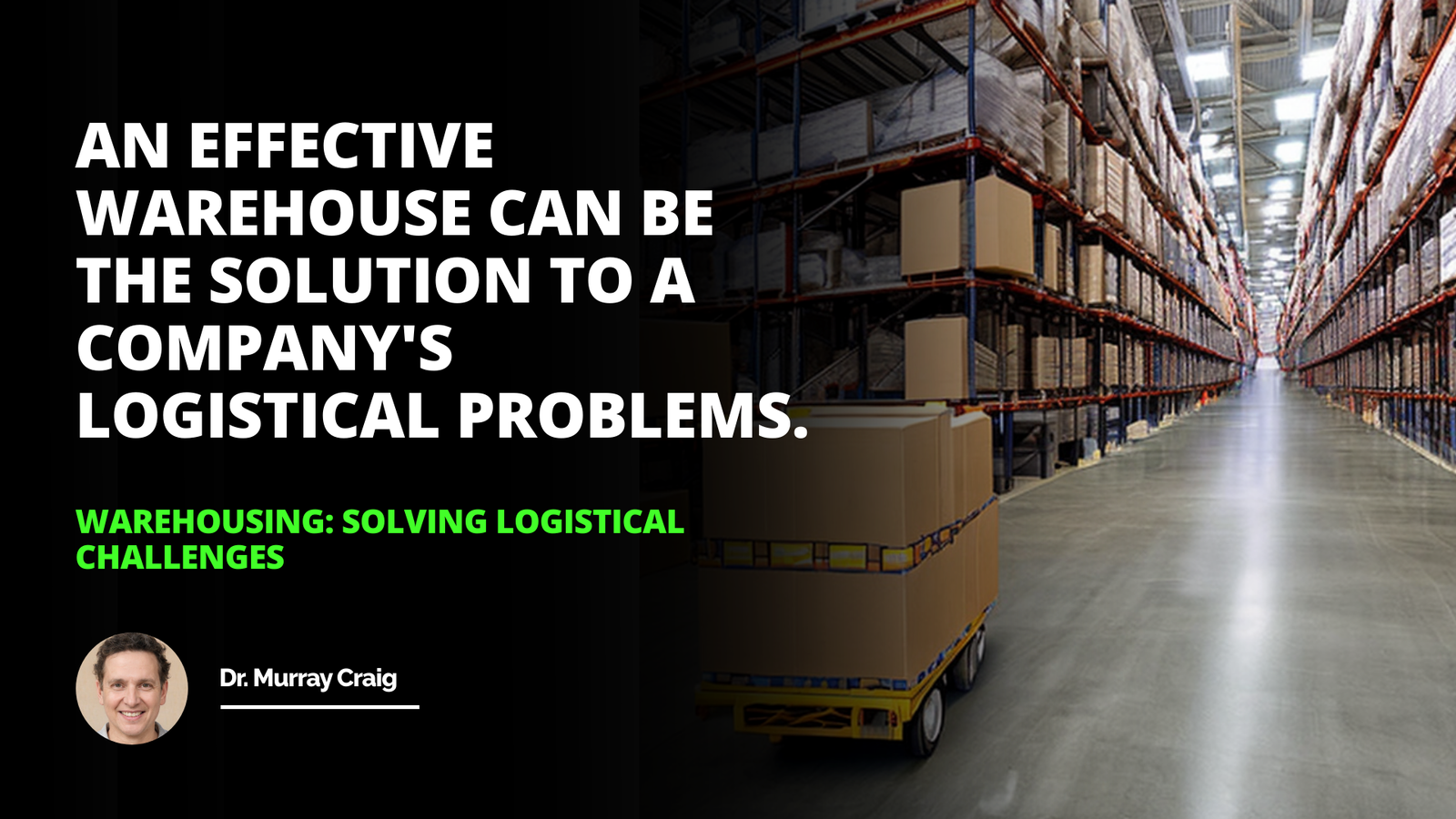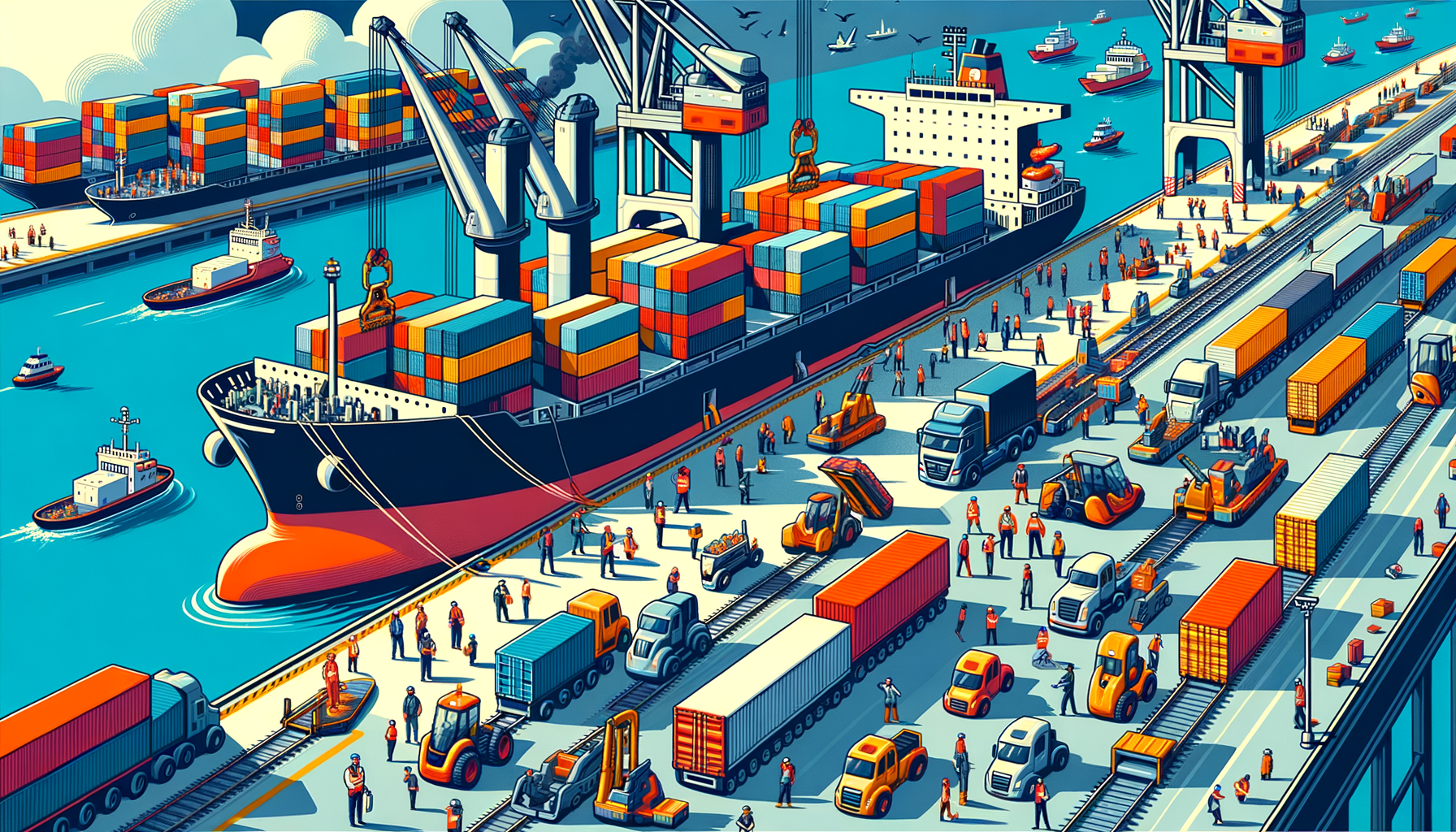
Break-Bulk Shipping: A Cornerstone of Global Logistics
In the intricate world of international shipping and logistics, different approaches are tailored to meet the multifaceted needs of global trade. Among these, break-bulk shipping has been a stalwart method, having sailed through the pages of maritime history and continuing to hold its ground in modern supply chain operations. This blog post delves into the intricacies of the break-bulk approach, a practice that involves the transportation of goods individually or in packages rather than in standardized containers. By understanding its definition, history, current significance, and the roles it fulfills in contemporary business practices, we gain an appreciation for this persistent shipping technique. Furthermore, we will explore the inherent advantages and limitations of break-bulk shipping while providing an expert, user-oriented analysis for those interested in what is break-bulk shipping definition or seeking specialized services for break-bulk freight in the field.
Definition of break-bulk
Break-bulk shipping is a method where cargo is shipped in individual units, bundles, or pallets, and often involves the handling of heavy, oversized, or non-containerized goods. Unlike modern container shipping, break-bulk cargo does not use standardized containers and thus requires manual sorting and handling upon loading and unloading from vessels. Goods that are typically transported using break-bulk methods include machinery, manufacturing equipment, large vehicles, construction materials, and commodities such as grain or timber.
Overview of the birth of break-bulk
Traditionally, all cargo was transported in this form, which necessitated a labor-intensive process to load and unload ships. This method has ancient roots, with evidence suggesting that break-bulk was the dominant mode of transport dating back to the times when raw materials and finished goods first traversed the seas. Break-bulk's birth reflects the absence of standardized containers and highlights the purely manual process of cargo transport which was prevalent for centuries.
Purpose of the blog
This blog aspires to inform readers, especially those looking to deepen their understanding or considering online certification courses in the realm of logistics, about the intricacies and applications of the break-bulk shipping method. We aim to provide a comprehensive and authentic exploration of its evolution from the cornerstone of historical maritime trade to its niche role within the intricate modern supply chain networks.
Understanding the Break-Bulk Methodology
Challenges faced
The method faced significant challenges that adversely affected the efficiency of shipping operations. These included slow loading and unloading times, increased labor costs, higher risks of theft and damage to cargo, and difficulties in tracking individual items. Further, it imposed limitations on ship design, as vessels had to accommodate various types of cargo within the same hold.
Importance during this period
Despite its inefficiencies, break-bulk shipping played a crucial role in historical trade, supporting the expanding needs of the industrial revolution, fostering international commerce, and playing a significant part in wartime logistics. The versatility of the method enabled traders and merchants to transport an array of goods across the seas.
Definition and Characteristics
Break-bulk shipping is a method where cargo is shipped in individual units, bundles, or pallets, often involving the handling of oversized cargo in break-bulk, heavy, or non-containerized goods. Unlike modern container shipping, break-bulk cargo does not use standardized containers and thus requires manual cargo sorting in break-bulk logistics upon loading and unloading from vessels (Stopford, 2009). Goods typically transported using break-bulk methods include machinery, manufacturing equipment, large vehicles, construction materials, and commodities such as grain or timber.
Reasons for shift
The shipping industry witnessed a significant transformation with the advent of containerization in the mid-20th century. The transition was motivated by the need for standardization, speed, and reduction in shipping costs. Containerized cargo's ease of transport, stacking, and transfer between different transportation modes outshone break-bulk's more archaic approach.
Impact on Break-Bulk shipping industry
Containerization revolutionized the logistics industry and diminished the overall reliance on break-bulk methods. While container ships swiftly became the backbone of high-volume sea freight, break-bulk maintained a foothold in areas that containerization could not adequately serve, such as transporting oversized or heavy-lift cargo.
Current global market trends in Break-bulk
In current global market trends, there has been a steady undercurrent of demand for break-bulk shipping, driven by sectors that require the transport of goods not suitable for containers. Harnessing this niche, break-bulk carriers have innovated to offer specialized services that meet precise industry requirements.
Importance of Break-Bulk in Supply Chain
Role in international trade
Break-bulk shipping occupies a unique position in the ecosystem of international trade by serving projects and industries that demand special handling and logistics planning. This mode remains pivotal for trade in regions with less developed infrastructure or where special commodities dictate transport requirements.
Facilitating more flexible transport options
The flexibility that break-bulk affords to specialized cargo provides shippers with more transport options. This is especially true for cargo with atypical dimensions or weights, where containerization would either be impossible or economically unfeasible.
Strengths of Break-Bulk
Flexibility in types and sizes of cargo
The principal strength of break-bulk lies in its ability to accommodate a diverse range of cargo types and sizes, granting the kind of flexibility that standard-size shipping containers cannot. This versatility is indispensable for certain sectors and shipment types.
Cheaper cost for certain types of delivery
For some cargo and routes, break-bulk can be more cost-effective than container shipping, particularly when the cost of containerization, including crating and decrating, outweighs the pure transport cost.
Limitations of Break-Bulk
Not suited for all cargo
The break-bulk method is not a one-size-fits-all solution and is ill-suited for cargoes that can be easily containerized or require the modular protections that containers afford. This limits its applicability to a subset of the shipping market.
More time consuming
The physical handling of break-bulk is more time-consuming than containerized cargo, both in terms of loading/unloading time and the necessity for careful stowage on a vessel. This can lead to slower overall transit times and potentially higher costs if not managed efficiently.
Historical Context and Evolution
The history and evolution of break-bulk cargo can be traced back to ancient times when raw materials and finished goods first traversed the seas. Traditionally, all cargo was transported in this form, necessitating a labor-intensive process to load and unload ships (Levinson, 2006). Break-bulk's birth reflects the absence of standardized containers and highlights the purely manual process of cargo transport prevalent for centuries.
However, the shipping industry witnessed a significant transformation with the advent of containerization in the mid-20th century. The transition was motivated by the need for standardization, speed, and reduction in shipping costs. Containerized cargo's ease of transport, stacking, and transfer between different transportation modes outshone break-bulk's more archaic approach (Cudahy, 2006). While container ships swiftly became the backbone of high-volume sea freight, break-bulk maintained a foothold in areas that containerization could not adequately serve, such as transporting oversized or heavy-lift projects.
List of Cited Works
The Role of Break-Bulk in Modern Supply Chains
Despite the dominance of containerization, break-bulk shipping occupies a unique position in the ecosystem of international trade by serving projects and industries that demand special handling and logistics planning. This mode remains pivotal for trade in regions with less developed infrastructure or where special commodities dictate transport requirements.
Further Recommended Readings
Advantages of Break-Bulk Shipping
One of the principal strengths of break-bulk lies in its flexibility to accommodate a diverse range of cargo types and sizes, granting a versatility that standard-size shipping containers cannot. This adaptability is indispensable for certain sectors and shipment types. Moreover, for some cargo and routes, break-bulk can be more cost benefits of break-bulk for large machinery than container shipping, particularly when the cost of containerization, including crating and decrating, outweighs the pure transport cost (Lun et al., 2010).
Disadvantages and Challenges
However, the break-bulk method is not a one-size-fits-all solution and is ill-suited for cargoes that can be easily containerized or require the modular protections that containers afford. This limits its applicability to a subset of the shipping market. Additionally, the physical handling of break-bulk is more time-consuming than containerized cargo, both in terms of loading/unloading time and the necessity for careful stowage on a vessel. This can lead to slower overall transit times and potentially higher costs if not managed efficiently (Branch & Robarts, 2014).
Break-Bulk vs. Container Shipping
When comparing break-bulk shipping vs container shipping, it is essential to understand their respective strengths and weaknesses. Container shipping offers standardization, efficiency, and ease of intermodal transport. It has revolutionized global trade by enabling the swift movement of goods across vast distances and between different modes of transport (Notteboom & Rodrigue, 2008). However, not all cargo fits neatly into the standardized dimensions of containers, and some goods require specialized handling that containers cannot provide.
This is where break-bulk shipping shines. It offers the flexibility to handle oversized, heavy, or irregularly shaped cargo that cannot be containerized. Break-bulk ships are designed with large, open holds that can accommodate a wide variety of cargo types and sizes. They also have specialized equipment, such as cranes and forklifts, to handle the loading and unloading of these diverse goods (Lun et al., 2010).
Real-World Applications and Examples
The importance of break-bulk in modern supply chain is evident in various industries that rely on this shipping method for their specific needs. For instance, in the renewable energy sector, wind turbine blades and other large components require the specialized handling that break-bulk shipping provides. Similarly, in the construction industry, break-bulk is often the preferred method for delivering large, prefabricated modules for mega-infrastructure projects like stadiums, bridges, or high-rise buildings.
Another example of break-bulk's significance is in the automotive industry. While many vehicles are transported using specialized roll-on/roll-off (RoRo) ships, some oversized or custom-built vehicles still rely on break-bulk shipping. Mining equipment, agricultural machinery, and other heavy equipment also frequently depend on break-bulk transport due to their unique dimensions and handling requirements (Lun et al., 2010).
The Future of Break-Bulk Shipping
Looking ahead, the future of break-bulk shipping is likely to be shaped by global trade flows, technological advancements, and infrastructural developments. While it is expected to face challenges from further advances in container shipping and intermodal transport, the specific needs of select cargo types will ensure that break-bulk retains its importance.
Harnessing the niche market, break-bulk carriers have innovated to offer specialized services for break-bulk freight that meet precise industry requirements. They have invested in modern vessels with enhanced capabilities, such as larger cranes and more flexible cargo holds, to cater to the evolving needs of their customers (Ducruet & Cariou, 2021).
Moreover, the growing demand for infrastructure development and renewable energy projects in emerging markets presents new opportunities for break-bulk shipping. As these economies continue to grow and invest in large-scale projects, the need for break-bulk services to transport oversized and heavy equipment will likely increase (Lun et al., 2010).
Conclusion
In dissecting the break-bulk approach within supply chain management, we find a method that is adaptable, industry-specific, and indispensable for certain forms of trade. Its persistence throughout history, specialization in modern logistics, and continued relevance provide fascinating insights for those pursuing what is logistics courses or preparing for the future challenges and opportunities of an ever-evolving industry.
Break-bulk shipping, with its rich history and unique capabilities, remains a cornerstone of global logistics. Despite the dominance of containerization, it continues to serve a vital role in transporting goods that do not fit the standard mold. As international trade continues to evolve, break-bulk shipping will undoubtedly adapt and innovate to meet the changing needs of industries and contribute to the cost benefits of break-bulk for large machinery in the years to come.
References
Branch, A. E., & Robarts, M. (2014). Branch's Elements of Shipping (9th ed.). Routledge.
Cudahy, B. J. (2006). Box Boats: How Container Ships Changed the World. Fordham University Press.
Ducruet, C., & Cariou, P. (2021). The geography of maritime networks: A critical review. Journal of Transport Geography, 90, 102903.
Levinson, M. (2006). The Box: How the Shipping Container Made the World Smaller and the World Economy Bigger. Princeton University Press.
Lun, Y. H. V., Lai, K. H., & Cheng, T. C. E. (2010). Shipping and Logistics Management. Springer.
Notteboom, T., & Rodrigue, J. P. (2008). Containerisation, box logistics and global supply chains: The integration of ports and liner shipping networks. Maritime Economics & Logistics, 10(1-2), 152-174.
Stopford, M. (2009). Maritime Economics (3rd ed.). Routledge.
Frequently Asked Questions
What are the key advantages and potential limitations of deploying the break-bulk approach in supply chain operations?
Break-Bulk Approach: Efficiency in Specialized Cargo Handling
When supply chain managers consider various shipping methods, break-bulk shipping often emerges as a focal topic. This method traditionally involves the transport of goods that are not containerized. Cargo ships carry individual, bagged, drummed, or bundled items. Several key advantages of this approach include flexibility in handling and the potential for expedited shipment delivery.
Flexibility in Cargo Handling
Break-bulk allows shippers to handle cargo that may not suit containerization. These goods include oversized items or machinery.
Special Equipment Not Necessary
In many instances, handling break-bulk cargo does not require special equipment. Ports can often unload these goods directly unto trucks.
Ease of Cargo Inspection
Authorities can inspect break-bulk shipments more easily. Inspection requires no full container unload.
Access to Smaller Ports
Break-bulk ships can often dock at smaller ports. Such ports may lack container handling facilities.
Expedited Shipment Delivery
Break-bulk may sometimes shorten shipping times. Goods can bypass large port congestion. They can move directly to the delivery site from a nearby, smaller port.
Direct Delivery
With break-bulk, direct delivery to the final destination may occur. This process avoids intermediary steps.
Reduced Warehouse Dependence
Need for warehousing often diminishes. Goods can move straight from the ship to delivery vehicles.
Potential Limitations of Break-Bulk
However, break-bulk shipping does face several limitations. These restrictions can affect the overall efficiency of supply chain operations.
Vulnerability to Damage
Goods shipped break-bulk may incur greater damage risks. They are not as secure as containerized cargo.
Weather Dependencies
Exposure to the elements can affect break-bulk cargo. Bad weather can significantly delay shipments.
Manual Labor Intensity
Handling of break-bulk goods often requires more labor. This process is far less automated than container handling.
Cost Variability
Costs can fluctuate more with break-bulk shipping. Price depends on the type and volume of goods shipped.
In summary, the break-bulk approach can offer significant advantages. These include flexibility in handling and potential for faster delivery. Yet, the approach brings potential drawbacks. Stakeholders must weigh these against the benefits. They should consider the nature of their cargo and specific supply chain needs. The decision to employ break-bulk shipping hinges on the balance of these factors.
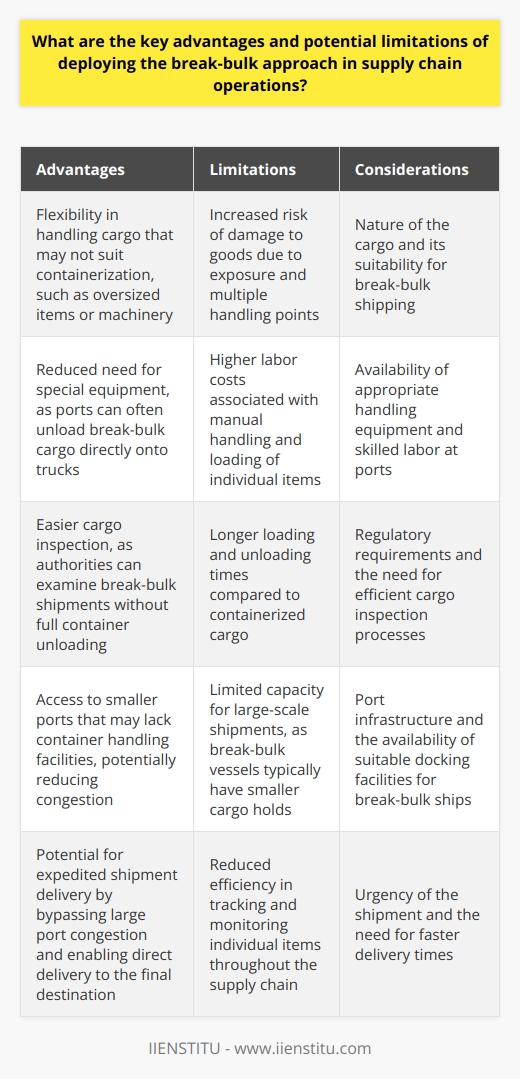
How does the break-bulk strategy enhance efficiency in the distribution process compared to traditional methods of shipping?
Break-Bulk Strategy: A Game Changer in Distribution
The distribution process plays a crucial role in supply chain management. Efficiency here ensures timely delivery and reduced costs. Traditional shipping often falls short. It involves large quantities, often moved intact from origin to destination. However, the break-bulk strategy has emerged as an efficiency booster in this regard. It involves deconstructing large shipments into smaller, more manageable units. This strategy has multiple benefits over traditional methods.
Enhanced Flexibility and Speed
Break-bulk creates flexibility. Distribution centers can handle smaller units faster. Freight becomes more manageable. Workers process shipments quickly. This increased speed means faster turnaround. Goods reach markets and consumers without delay.
Reduction in Handling Time
Smaller units reduce handling time. They are easier to move and stack. Distribution workers handle these with greater ease. This acceleration in handling time slashes overall transit periods.
Improved Inventory Management
Break-bulk aids inventory management. Businesses can track smaller units better. Such granularity improves stock control. It reduces overstocking risks. It allows for more accurate inventory forecasting.
Greater Accessibility
This strategy opens more destinations. Smaller shipments can reach remote areas. Large cargoes may not suit such locations. Break-bulk makes logistics in these areas possible.
Tailored Shipping Options
Break-bulk enables tailored shipping. Distributors can mix and match cargoes. They can respond to specific market demands. Traditional shipping lacks such precision.
Risk Mitigation
Risk spreads out with break-bulk. Smaller shipments mean less risk per unit. Damage or loss has a lesser impact. This decentralization of risk protects suppliers and customers alike.
Cost Efficiency
Costs reduce with break-bulk. Handling smaller units often costs less. Warehousing expenses drop. Transportation becomes more economical. These savings travel down the supply chain.
In essence, break-bulk outperforms traditional shipping methods. It transforms the distribution process. It adds speed, reduces costs, and improves service levels. The break-bulk strategy simply makes the distribution process more efficient.
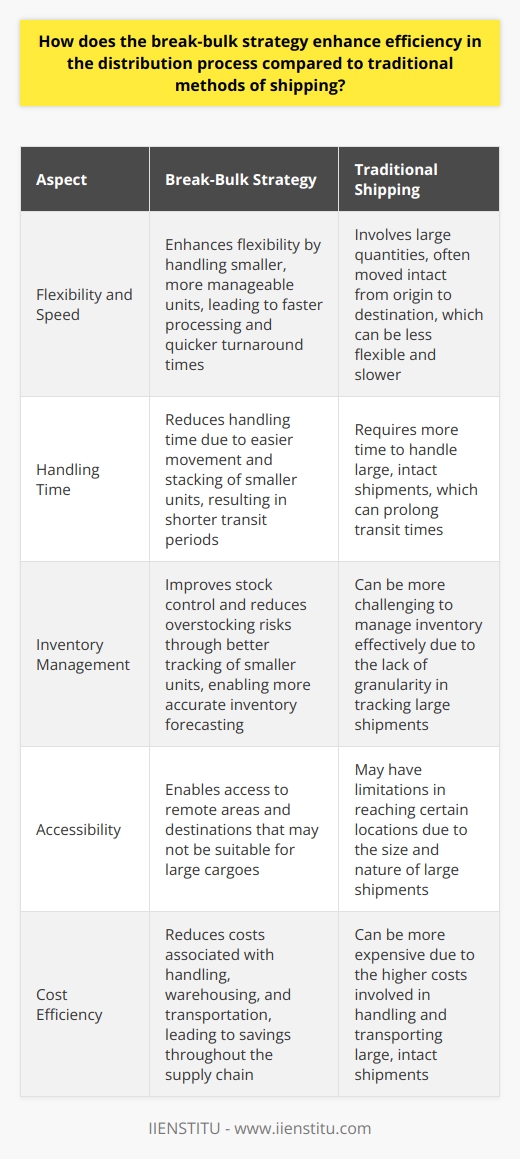
In what specific scenarios or type of supply chain operations would the break-bulk approach be most beneficial and why?
Understanding Break-Bulk in Supply Chain Operations
What is Break-Bulk?
Break-bulk refers to splitting up shipments. It moves goods from a single transport mode to multiple smaller vehicles. This approach enables diverse delivery destinations within supply chains.
Benefits of Break-Bulk
Efficiency in handling stands out. Each item gets individual attention. This reduces damages and losses. Bulk goods convert into manageable units.
Customization increases in transport. Specific goods go to precise destinations. It adapts well to complex shipping routes. Supply chain players can alter routes swiftly.
Cost savings emerge as well. Smaller shipments incur lower charges. It uses local delivery networks well. Cash flow improves as smaller consignments ship faster.
Scenarios for Break-Bulk Effectiveness
High-Value Goods Transportation
Luxury items need careful handling. Break-bulk ensures secure and focused delivery. Its method suits high-value items best. Such goods require specialized logistics care.
International Trade Involving Multiple Destinations
Overseas shipments often have diverse endpoints. Break-bulk divides cargo for various countries. It excellently fits extensive geographical coverage. Global traders find this method vital.
Supply Chains with Flexible Delivery Points
Retailers often change delivery sites. Break-bulk provides necessary flexibility. Supply chains can adapt to changes fast. Retail environments benefit greatly from this.
Situations Demanding Quick Order Fulfillment
Fast-moving consumer goods need rapid distribution. Break-bulk shortens last-mile delivery times. It supports supply chains that promise quick turnovers.
Projects with Specialized Equipment Transport
Heavy machinery requires specific handling. Break-bulk allows for transport customization. Each item gets appropriate conveyance. This method is crucial in machinery logistics.
The break-bulk method shines in specific scenarios. It secures high-value goods and aids international trade. It also improves adaptability and speed in retail chains. Plus, it transports specialized equipment safely. Supply chain operations embracing break-bulk often see enhanced benefits. This approach is key for intricate and dynamic distribution models.
